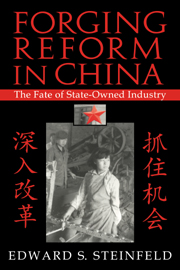Book contents
- Frontmatter
- Contents
- List of Tables and Figures
- Preface
- 1 Introduction: China's Ailing State Enterprises
- Part I Conceptual Approaches to Postsocialist Enterprise Reform
- Part II Enterprise Case Studies: The Commanding Heights in Transition
- 4 The Living Museum of Iron and Steel Technology
- 5 King of the Red Chips: Ma'anshan Steel and the Debacle of the “Public” SOE in China
- 6 Shougang: The Rise and Fall of an Industrial Giant
- Part III Reassessing Chinese Patterns of Economic Development
- Notes
- Bibliography
- Index
5 - King of the Red Chips: Ma'anshan Steel and the Debacle of the “Public” SOE in China
Published online by Cambridge University Press: 12 January 2010
- Frontmatter
- Contents
- List of Tables and Figures
- Preface
- 1 Introduction: China's Ailing State Enterprises
- Part I Conceptual Approaches to Postsocialist Enterprise Reform
- Part II Enterprise Case Studies: The Commanding Heights in Transition
- 4 The Living Museum of Iron and Steel Technology
- 5 King of the Red Chips: Ma'anshan Steel and the Debacle of the “Public” SOE in China
- 6 Shougang: The Rise and Fall of an Industrial Giant
- Part III Reassessing Chinese Patterns of Economic Development
- Notes
- Bibliography
- Index
Summary
INTRODUCTION: MAGANG GOES PUBLIC
ON October 26, 1993, the Ma'anshan Iron and Steel Company (“Magang”) completed its offering of “H” shares on the Hong Kong stock exchange, thus becoming one of the first large-scale state-owned enterprises in China to, in effect, “go public.” Ma'anshan Iron and Steel – a sprawling 85,000-employee integrated steel operation on the banks of the Yangtze River – by most measures represents the cutting edge of property-rights reform in Chinese industry. It is a state-owned firm whose assets have been evaluated by a Western accounting firm and whose stock freely circulates on both domestic and international securities markets. Magang is an SOE whose owners now include nonstate actors and whose internal governance structure has been made to resemble corporate models from developed capitalist economies. In the broadest sense, the newly “corporatized” Ma'anshan Iron and Steel is engaged in a revolutionary property-rights experiment that Chinese policy makers hope can save the last great remnant of state socialism in the People's Republic, the large-scale state-owned industrial enterprise.
The overseas listing of Chinese SOEs – an experiment that by 1997 included over thirty firms – aims for a series of interlinked, extremely ambitious goals. Policy makers hope that corporatization can in one fell swoop depoliticize the firm, increase efficiency of asset use, and ultimately increase revenue flows from the firm to the state. The underlying premise is that SOEs perform so poorly not so much because the owners happen to be governmental per se, but rather because the number of government bodies claiming ownership privileges is far too many and the actual financial stakes linking those bodies to the firm far too few.
- Type
- Chapter
- Information
- Forging Reform in ChinaThe Fate of State-Owned Industry, pp. 124 - 164Publisher: Cambridge University PressPrint publication year: 1998



